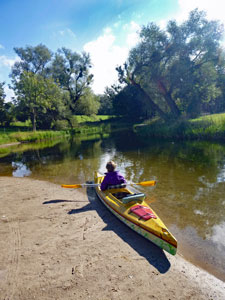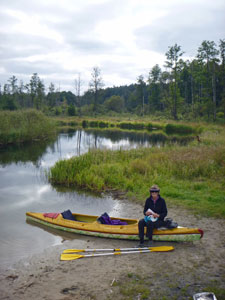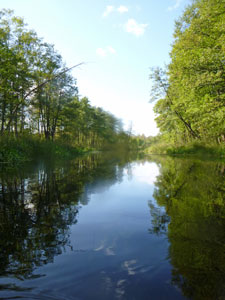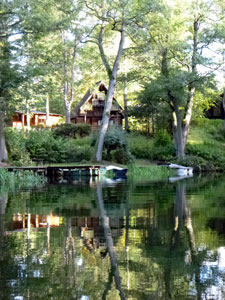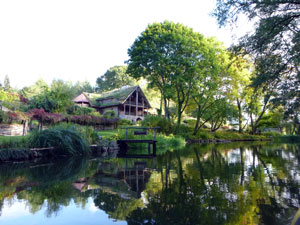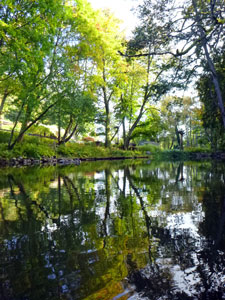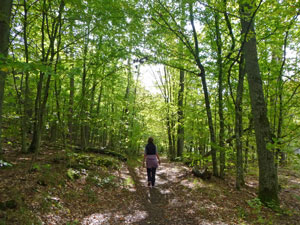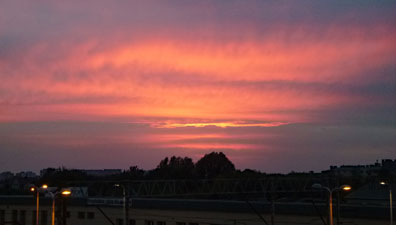| Kayaking Krutynia |
Getting There |
It took a bit of planning to get from the Latvian capital of Riga, to the small village of Krutyn in the heartland of Poland's Mazurian lakes. However, after a 7 hour bus trip across Latvia and Lithuania into north-eastern Poland, an overnight stay at Augustow, a 90 minute local bus trip from there to Bialystok and a 4 hour drive in a rental car, we arrived in this beautiful area of forests and lakes, checking in to our comfortable family-run hotel for a well earned rest. There are over 2000 lakes from one hectare to over 100 km2 in the forests of Mazuria. I had read about this land of lakes and waterways and it seemed a good place to complete our circuit of the countries that border the Baltic Sea. After almost two weeks being tourists in the big cities, it would be a chance to relax once more in the peaceful countryside. We chose Krutyn because it is on the Krutynia River that flows through the Mazurian Landscape Park and which is famed as a canoeing / kayaking route. A couple of days kayaking, exercising neglected upper body muscles, seemed a great way to spend the last few days of our trip. |
 Houses in the village of Krutyn |
|
Day 1 - Krutyn to Ukta (14.5 km) |
The family who run our hotel also rent out kayaks and offer transport along the river, so it was a simple matter to organise our kayak trip. All that was needed was to resurrect enough of my high-school German. Our kayak and us were dropped off just down from the hotel. As we left the little wooden pier, the sun was out and the air had a touch of autumn crispness - it was going to be a good day. |
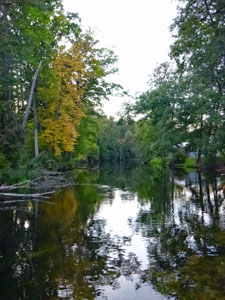 A splash of autumn colour on the Krutynia |
 |
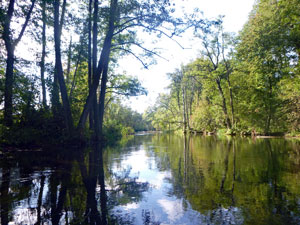 A stretch of still tree-lined river |
The swift-flowing current quickly carried us away, beneath the green canopy of river-side trees. Here, the river was shallow and the water crystal clear - all was visible as we glided along above a bed of water plants, their long strands stretched out by the current above a sandy bed dotted with freshwater mollusc shells. Apart from the manoeuvres needed to pass the occasional fallen tree trunks, paddling was almost optional in the fast current. |
||
 What the rear paddler sees |
 Reflections on a broad reach of the river |
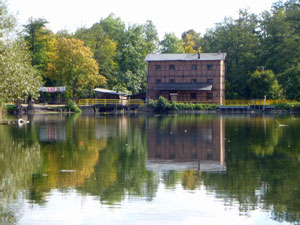 Approaching the mill at Zielony Lasek |
It was lovely winding our way down beneath the leafy riverscape, the local swans and ducks unfazed by our appearance and passing. After a short while, we reached our first (and only) obstruction - at the narrow passage that marked the end of a still broader reach, the stream flowed directly beneath a large pink-walled building. It was the mill at Zielony Lasek. |
||
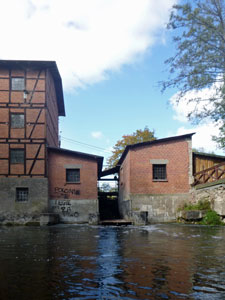 The outflow from the mill |
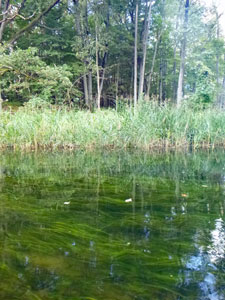 River weeds and crystal clear water |
 Paddling beneath the big trees |
The miller had been watching and when we pulled in to a landing just to the right, he was waiting with his trolley to wheel our canoe the 30-40m past the mill to the river downstream - an easy 5 zloty and a nice way to earn some beer money. |
||
 At times the Krutynia is lined by beautiful forest .... |
 .... at times it passes thick reed beds ..... |
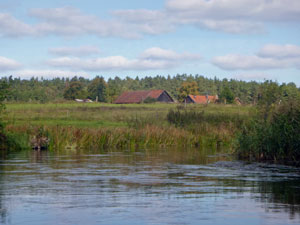 ..... and at times it flows alongside farmland and farms |
The section below the mill reverted to a narrow and fast-flowing stream, lined with trees and overhead branches, all reflected in the glassy surface. This continued until we reached a riverside camping area and bar/restaurant at Rosocha. In summer it would have been a great place to stop for a coffee and cake, but, in late September, the high season was well gone and the place was closed. However, given the number of rental kayaks on racks along the river, the Krutynia must fairly buzz in summer. We were happy to be experiencing the tranquility of being along on this beautiful river. |
||
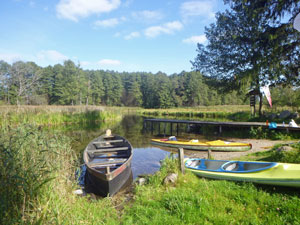 Lunch sop at Chostka pier |
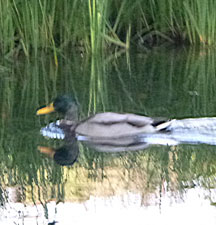 |
 There were just a few others paddling down the river |
The surrounds were now starting to change, with reed-beds extending out from the shore. More and more clearings appeared as we started to paddle our way through farmland., passing the tiny hamlet of Chostka to find a small wooden pier at the next hibernating camping area. It was a good place to stop for a bite of lunch and a chance to rest aching glutes. From the campsite, the river ran deeper as it meandered its way between ever thicker reed beds - with deeper water came a slower current and the need for more paddling effort - it was time to concentrated on rhythm and synchrony. After a period of steady paddling we reached a point where a narrow channel broke out into the river from the wide expanse of reeds. We turned and followed its narrow course (barely enough room to swing a paddle on either side) deep into swamp. After winding our way several hundred metres down this claustrophobic channel, we emerged into the wide open waters of Dus Lake - our first Mazurian lake. |
||
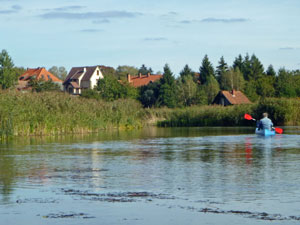 Approaching Wynowo village |
 The narrow passage through the reeds to Dus Lake |
 Emerging into Dus Lake |
Time was against any exploration of the lake and the Orthodox monastery at its far end, though, as we had a 3pm pick-up downstream at Ukna. Thus, we retraced our path back though the thick and tall reeds to rejoin the river, glad to get some help from the current again. Ahead lay the houses of Wynowo, with their deep access channels cut through the reeds to the shore. |
||
Passing under the old wooden road bridge that led to the village, the river straightened up to form a long reed-lined reach. With not a breath of air, the reflections of the surrounding vegetation and houses were superb. We had found a steady paddling rhythm, the sun was shining, the air was still and the afternoon light was luminous - life was good. |
|
|
 Afternoon reflections on a slow reed-lined reach |
 Nearing the outskirts of Ukta village |
|
All too soon, the houses of Ukta began to appear and, in no time, we had paddled under the bridge and pulled in to the sandy landing on its other side. Our kayak man was waiting with van and trailer to take us all back to Krutynia and, in no time, we were back at our hotel having a hot shower. It had been a superb and peaceful autumn day on the river - we had seen only two other kayaks all day. however, as mentioned earlier form the number of kayak rentals available in village and campground, this would not be the case in summer. it looked like it could become a log jam in high season. So, for the ultimate experience in still water kayaking and to enjoy the tranquillity of this beautiful river and the forest that lines it, come in autumn when everyone else has gone back to work and school. |
|
Day 2 - Ukta to Iznota (16.5 km) |
Our good fortune with the autumn weather continued, as we were driven out to the day's starting point at Ukta. Kayak unloaded, packed lunch and dry bag of essential gear on board and we were away. Once again, we found ourselves starting on a section of fast-flowing, shallow and incredibly clear water beneath the shade of overhanging trees. |
|
|
 Once more into the still forest .... |
 .... and reed-lined banks .... |
|
Passing some of the riverside houses of Ukta, we soon met our first swans and ducks. They passed nearby with splendid indifference to our presence. The left bank was now opening up to pasture lands and with the lack of tree cover, the reed-beds thickened. Soon we found ourselves paddling down a relatively deep channel, thick with submerged water-weeds, as it passed through forest-lined reed-beds - we were now in the Rezerva Krutynia Dona, one of several protection areas within the Landscape Park. In fact this area of meandering river and tall and dense reed beds is known as Mala Amazonka - the Little Amazon. |
||
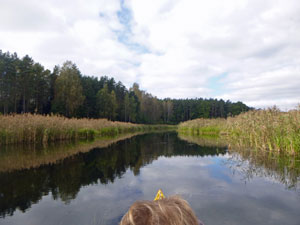 Paddling through the Mala Amazonka |
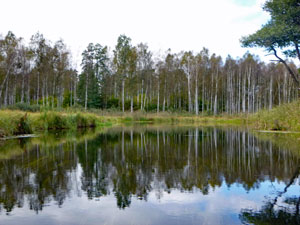 Passing through the birch forest |
|
Reaching a sweeping bend, we noticed a small silty beach within the reeds - a good spot to pull in and have a standing break. I find that after an hour of kayaking my backside starts to ache, no matter what amount of rubber foam the seat may have, so that tends to be my limit or spells of paddling. The channel was getting deeper and the current slower as we meandered our way down through the reed-bed. On several bends, we rounded the reeds to be presented with a view of silver birch trunks reflected in the water ahead, a nice distraction form the steady push through the reeds. On the longer straights we distracted ourselves by cranking up the paddling rate to see what speed we could reach - 6kph - not sure whether that is good or bad, but the reeds passed by quickly. Soon we had reached the bridge at Nowy Most and a nice beach and picnic spot to pull out and enjoy lunch on dry land. |
||
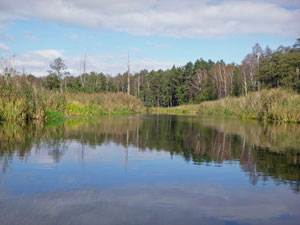 A long reach just before Nowy Most |
 The clarity of the Krutynia water |
|
After lunch, we continued the meandering paddle northwards. For a while, forest encroached on the right bank, but soon we were back in the reed-beds. The channel, however, was becoming deeper and darker, until it finally opened up into the broad waters of Lake Gardynskie. The lake itself seemed very shallow, with many small islets of reeds breaking out above the surface. The water was still clear, but the bottom was a thick lay of black silt, which gave the water surface a much darker appearance. |
||

|
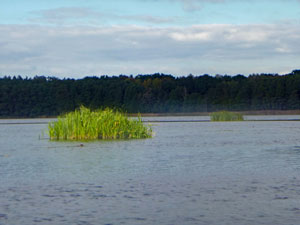 Floating islands in Lake Gardynskie |
 The channel between Lakes Gardynskie and Malinowko |
We turned right on entering the lake to hug the shore-line, keeping our eyes open for the opening of a narrow channel through the reeds. Turning into it, we quickly passed the reed beds and the channel became a tree-lined boulevard that led us into the next lake, Lake Malinowko, smaller but prettier, with thick forest lining its banks. |
||
 In the middle of Lake Malinowko |
 Rest stop on the shore of Lake Malinowko |
|
We paddled across a corner of the lake, spotting the exit channel and a small beach in the forest at the same time. It was break-time, so we pulled in to shore and climbed up to the remains of an old campsite. It was good to have a brief wander and get a better feel for the Mazurian forest. |
||
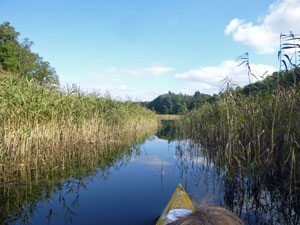 Reed-lined channel between Lakes Malinowko and Jetzewko |
 Reflections on Lake Jetzewko |
|
Heading off again, we passed through a narrow gap in the 2m tall reeds to emerge into what was either a wide river or a narrow lake - the deep, dark and still waters suggested the latter and it was very pleasant cruising down it, rippling the mirror-like surface that reflected tree and cloud. Along the way, we passed a fisherman sculling along in his wooden rowboat. He was the only other person that we saw on the river today, such is the tranquillity of kayaking Krutynia out of season. |
||
|
After a while, the lake narrowed to a channel that led us into the little hamlet of Iznola - and gave us one last opportunity to glide in the shade of overhanging trees, as we passed the houses to reach our end-point at Iznola Bridge.
|
|
However, we had arrived earlier than our pick-up time, so we pushed on another few hundred metres to reach the mouth of the river as it flowed out into the large Lake Beldany - it was good to visit one more of the Mazurian Lakes (now having "done" 5 out of the 2000).
|
|
|
After paddling a small circle on the lake, we headed back upstream to the bridge at Iznota and pulled out on the sandy beach alongside, some ten minutes early - it is always nicer to be the waitee than the waiter. The slight ache in our arms and shoulders after two days of paddling felt good - after eleven weeks devoted to walking and cycling, our upper bodies were definitely in need of a work out. The slight euphoria of the mind felt even better - the Krutynia River was one of the best stillwater paddling trips that I have done and, now, whenever anyone mentions the word Masuria, I will be able to conjure up images of the beautiful clear rivers, reed-fringed lakes and dense green forests of this region. |
|
Day 3 - A short walk along the Krutynia (4 km) |
On our last day before driving back to Bialystok and catching the bus to Berlin, we still had a bit of time to further explore. The temperature was almost balmy, so a walk in the park seemed a good idea - the Rezerva Krutynia to be exact - along a short track that followed the Krutynia River through the pristine forest. We parked the car at a canoe drop area, just a few kilometres north of the village and set out. |
 Lake Krutynskie |
 On the old road by Lake Krutynskie |
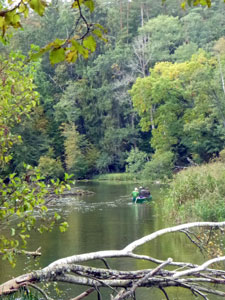 View down the Krutynia River |
The track started at the end of Lake Krutynskie, surrounded by reeds and trees, and followed the cobbled piste of an old road into the forest by the rivers edge. Soon the lake was behind and the shallow, quick-flowing, crystal clear water of the river was quietly flowing down through this superb mixed pine and hardwood forest. |
||
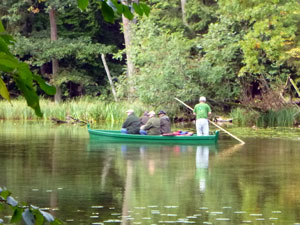 Pole boat on the Krutynia |
 |
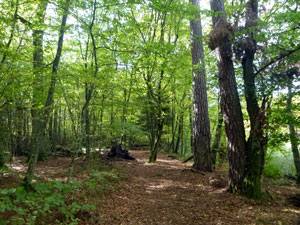 In the forest of Krutynia Reserve |
It was good to see the river from the bank, as well as from a kayak. The reflections of overhanging branches and fallen trunks seemed so much clearer and the swan in the reeds kept on sleeping as we crept by. The road soon turned toward the river and abruptly ended, replaced by some submerged wooden planks and few stumps, where once a bridge used to be. We headed on along a smooth shore-line footpath, beneath the forest canopy, but always able to admire the clarity of the river and its reflections. |
||
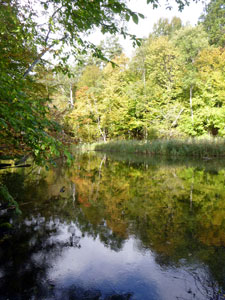 River reflections |
 Tree felled by a beaver |
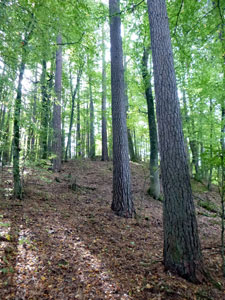 The open forest along the river |
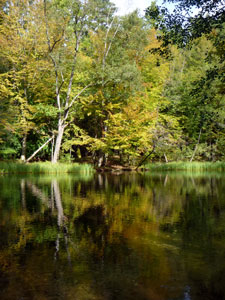 Autumn approaching |
A little later, we came across some river's-edge trees that had fallen, their bases gnawed in a neat circle. At last we knew why there were so many tree trunks submerged along the course of the river - beavers! One small trunk, still standing, was freshly gnawed with large chips around its base - the local beaver was doing his thing. |
|||
|
|
|
Thus, the walk continued beneath the magnificent forest canopy, with its open floor of dried leaves and scattered herbs, beside the meanders of this lovely tranquil river. The autumn colour was just appearing, which added to the scene. After a couple of kilometres, we reached some wooden jetties and the long wooden boats that the locals pole along with their load of summer tourists - all back at rest for the autumn. We had reached the outskirts of Krutynia and the border of the reserve. |
||
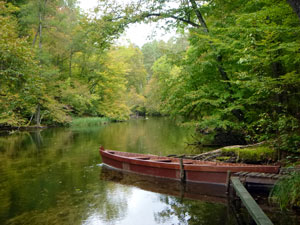 Boat pier at Krutyn Boat pier at Krutyn |
 Pale green leaves and russet leaf litter |
|
It was time to turn around a retrace our steps, enjoying it all again. One last task remained - in keeping with tradition, I took my walking boots which had finally worn themselves out on this trip, and placed them at the base of a tree overlooking the Krutynia - a great place to for a pair of well-served boots. Then it was time to go home. |
|
|
Bonus: Cultural Mazuria (distances) |
Although most renowned for its natural landscapes, Mazuria is a region with a rich history. From the early Prussian tribes to the Teutonic Knights, ruled at times by Poles and Lithuanians, Germans and Russians, and fought over by tsars and emperors. Megalomaniacs such as Napoleon and Hitler head-quartered here during their failed attempts to invade Russia. More recently, part of the German province of East Prussia, it finally became part of Poland in 1945 following the end of World War II. Masuria is full of fortifications from many periods and also has many churches, cathedrals and religious buildings from periods when catholic or protestant held sway. What can one do and see in a day amongst all of that? Between days of kayaking and walking, we chose a short driving itinerary to visit four locations - an old church, an even older fortress, an isolated rural village and a remnant of one of humanities darker periods. |
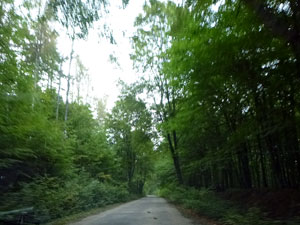 Country road in Mazuria |
 The 17th century Marian Sanctuary at Swieta Lipka
|
Thus driving north from Krutyn through the deep green forests, with just a hint of autumn colour developing, and past some of the many lakes they surround, we headed for the small town of Święta Lipka. Built here in the early 17th century, was our first stop, the Jesuit-run Sanctuary of St Mary. This building is a jewel of baroque architecture, from its ornate iron gate and painted cloisters, to the salmon pink walls, marbled columns and ornately-gabled exterior of its twin towers and the fresco-covered ceiling, rich woodwork, and ornate organ of the interior. If you like baroque, join the 100,000 people a year who visit it - fortunately, not on a dull autumn day such as today. |
|
 Painted cloisters of the Sanctuary |
 The magnificent baroque organ and ceiling |
|
Our next stop was just a few kilometres away, at Reszel. Here, in the 14th century, the Teutonic Knights built one of their many fortress castles - a large red brick square building with an interior courtyard. It had fallen into disrepair over the centuries, but has now been restored to be one of the best examples of the architecture of the Teutonic Order. A climb up to the top of its large round tower provided us with great views out over the buildings of Reszel to the countryside beyond. |
||
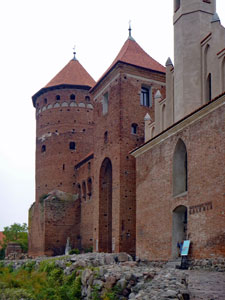 Reszel Castle - built by the Teutonic Knights |
|
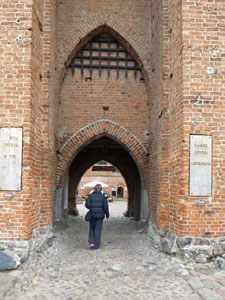 Entering the castle |
Our third stop was a little different - at the end of a narrow pot-holed road in the flat farmlands just south of the Russian border lies the little village of Lwowiec, almost a time-warp from the earlier part of the twentieth century. Few people seem to live here now, but the church is an impressively large red-brick building with stepped gables that supported several stork nests - a sign that once there were many more people. Once it was called Löwenstein and had been inhabited by Germans for over 500 years from the 15th century. The area was then East Prussia, but in 1945 they were forced to flee the onset of the Red Army. Many never made it back to the heartlands of what is now modern Germany. So why visit this out of the way place with such a sad history? Amongst the German inhabitants were many with the same surname as my own and, in Löwenstein, the name can be traced back to 1598. My ancestors are from West Prussia and there is no known connection, though I suspect that we all have a common ancestor from even earlier times. One day I hope to find the proof. For the moment, I just wanted to get a feel for where these people lived. |
 The old Lutheran church at Löwenstein |
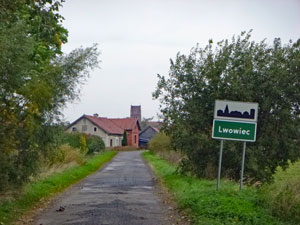 Entry to Löwenstein (now Lwowiec) |
 Old village buildings (note the storks' nests) |
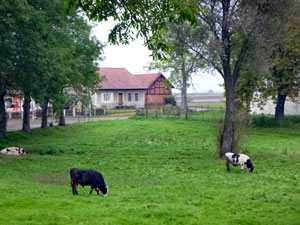 Rural scene in Löwenstein |
Then it was time to turn south - a darker side of history awaited. Deep in the Masurian forest just east of the town of Ketrzyn, lay the ruins of Wolfschranze - Wolf's Lair - the war-time eastern headquarters of Adolph Hitler, where he spent much of his time up until 1944, overseeing the invasion of Russia. As Napoleon could have warned, that was a bad idea - the campaign was a monumental disaster that probably cost him World War II, and Hitler fled Wolf's Lair in September 1944, just ahead of the Red Army advance. A few days later, the German Army tried to blow it up, but this complex of immensely thick-walled concrete bunkers refused to disappear. |
|||
 In the forest of Ketrzyn |
 Moss-covered bunker at Wolf's Lair |
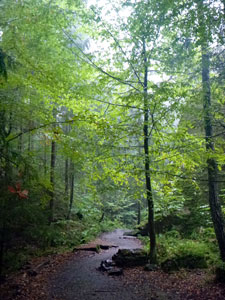 The trail through Wolf's Lair |
 Like a temperate Angkor Wat |
It remains today as a reminder of the folly of war and how the madness of a few can so affect the lives of many. For that, we were hesitant to visit the place - does evil have a lingering presence? Not at Wolf's Lair - the forest of Mazuria has cleansed the site. As we wandered through the ruins in the falling rain, the whole place resembled a European Angkor Wat, cracked and crumbling concrete monoliths, covered in moss, tree and shrub growing up through the fallen blocks. The soft greenery enfolded the Lair and restored its tranquillity. We were glad that we came to see it. |
|||
 Ruins reclaimed by the forest |
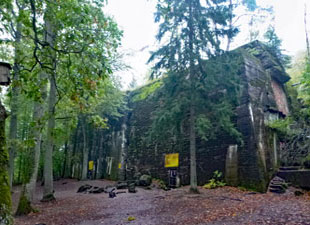 The massif concrete block of the Fuehrerbunker |
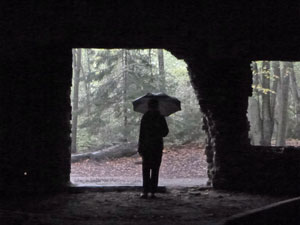 Wet day at Wolfschranze |
Thus, ended our cultural snippets of Masuria, and our Circuit of the Baltic Sea. An overnight bus trip to Berlin and a flight back to Australia awaited, but these few days in this green and, now, peaceful part of the world were the perfect way to finish this long adventure. |
||
|




